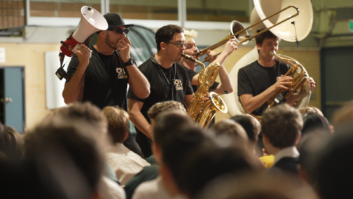
Advice from Polycom on how teachers can use technology to help better educate, engage and inspire students in the classroom
Motivating, educating, and inspiring students to be fully engaged in the classroom can be a tall order for many teachers to overcome. Teachers may have to implement creative ways to disseminate information so that students can better absorb, retain, and enjoy the learning experience. And this is where the use of modern communication technologies in the classroom, specifically video, can come into play.
Below are five ways schools can enhance the student experience using video in 2018:
Group Therapy
In the counseling world, many patients connect with therapists through text and video chat. They also participate in group sessions online. So why not bring the group online therapy approach to schools?
Group sessions often serve as a cornerstone of therapy as individuals develop self-awareness by listening to others with similar issues. And sharing one’s experiences with others who have similar problems is often therapeutic by itself.
Conducting group therapy sessions online through video conferencing shouldn’t take away from the experience of meeting physically. Utilizing video can be an excellent tool to supplement face-to-face meetings, especially when distance plays a big factor.
A recent EdTech article shares ways in which K-12 counselors can better reach their students by incorporating online group therapy. In conjunction with sharing thoughts and feelings with one another, students can also share thoughts and feelings online through the use of multimedia projects. These can include a weekly visual journal, and mind maps for discussions and message boards.
Using video conferencing platforms in this way can “allow students to be creative and show how they feel in a safe online space, rather than just speak about it in a group.”
Bring in High Profile Guests for a Live Q&A
While inviting guest speakers into the classroom is rewarding, it can also be extremely challenging. Finding and booking the right speaker and scheduling their time, which includes travel, can get tricky.
Video chat, however, can help solve this dilemma as guest speakers can seamlessly connect with students through a reliable and secure platform.
John Boyer, a World Regions Geography Professor at Virginia Tech, is known for using modern technologies to enhance the learning experience for his highly sought out course.
His teaching philosophy is simple: “make it accessible, and make it relevant.” And his unique teaching style, which often incorporates his fun alter-ego character – The Plaid Avenger – coupled with the technologies students are accustomed to using is what keeps the 3,000 plus students actively engaged.
One of the many ways he incorporates modern technology to enhance the learning experience is by bringing on some high profile guests through a live Q&A video chat with the students.
Some of the notable and high profile guests he’s featured include the former Prime Minister of Australia, Kevin Rudd, and Nobel Peace Prize recipient and Burmese pro-democracy advocate, Aung San Suu Kyi.
Here is a short and entertaining video featuring Professor Boyer and his students requesting a video chat with Aung San Suu Kyi.
Take Students on Virtual Field Trips
Thanks to advances in video conferencing, students can travel and explore the world’s wonders – all at the click of a button.
Take for instance Washington State’s Puget Sound in which students recently had the opportunity to get up-close-and-personal with Orca whales and other marine creatures in the Puget Sound ecosystem – all from the comfort of their classrooms.
In Journey to the Parks: Explore the Salish Sea, students from all over the globe were able to enjoy a quality experience and interaction with onsite experts through a moderated chat function.
From this live interactive experience, students were able to learn the four criteria that whale researchers use to identify individual whales and why tracking individual whales is an essential part of whale research.
Students also participated in a hands-on/minds-on activity in which they experienced what it’s like to communicate through sound only. They were also able to identify different killer whale pods based on recordings of the Puget Sound Killer Whale pods.
Collaborate with Other Schools
Students love to socialize, and they love using video to chat with one another.
Why not leverage video conferencing to connect classrooms with students in other parts of the world for collaborative learning?
St. Thomas the Apostle, a private school in West Hempstead, New York took this approach when connecting their students with a classroom in Ghana through the nonprofit Global Nomads Group.
Students talked about what it meant in the U.S. to have its first African-American president, and the Ghanaian students spoke about their first democratic election, and what it meant to them.
Video conferencing between schools can give students from different cultures a chance to discuss common issues and current events, including how they can work together to solve global problems.
In addition, video conferencing tools can expose students to the technologies being used in the workplace to collaborate with colleagues across the globe effectively. Knowing how to communicate effectively and how to use the right tools is one of the most commonly referenced skills employers seek, so it only makes sense to expose students to this technology platform (s) while they are in school.
Connect with Parents
Video chat doesn’t just need to be used in the classroom; teachers can also use the platform to connect with parents outside the classroom.
Parent involvement is critical, but getting involvement from them and discussing student issues can be hard when schedules are busy. Utilizing video conferencing can serve as an excellent and more convenient alternative to connect with parents, even for a parent-teacher conference.
No matter the time or place, video can bridge the gap of connecting face-to-face with a simple push of a button on a platform parents are accustomed to using, including mobile devices.
The student learning experience will continue to evolve. Incorporating video conferencing in a creative way within the classroom may be the ticket teachers need in 2018 and beyond to enhance the overall learning experience for students as they enter the future workforce.
This article first appeared on Polycom’s WorkSpace Today website and was written by Marc McCormick







